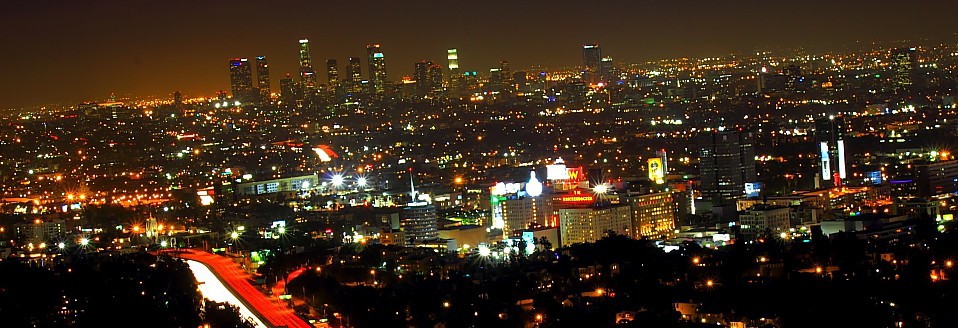Jam packed with art from galleries that focus primarily on New York and Los Angeles, Frieze Art Fair, now located at two locations within the Barker Hangar Complex at Santa Monica Airport, is an exciting art event.
Shuttles ferry visitors from the “west” to “east” complexes, with the east end being the far larger venue. Along the way there are large-scale sculptures – an airplane, a “loot” bag, and some extremely cool 3-D holograms with fans, “Hologram Phantom Limbs” from Jennifer West that shift and spin differently in person and when photographed. Sculptural forms are in fact everywhere, from fabric to mirrored pieces to neon to resin; booths are extremely well curated, offering the experience of visiting the actual gallery displaying work, just a capsule-sized version.

The main building and the largest collection of galleries is located on the east end of the complex; a smaller satellite exhibition is on the west end. Both house a mix of primarily contemporary, cutting-edge art – but make no mistake, this is highly polished work featuring names you’re bound to know, from Damien Hirst to Doug Aiken.
There were many works featuring miniature items, many involving mirrors and other shiny sparkly materials, lots of dimensional works, political works, humorous works, and vibrantly colored abstract and modern expressionist art. So, in short, there is a lot of art from impressive galleries in breathable spaces allowing viewers to take the works in without feeling crowded or rushed – although the fair itself is certainly busy.
It’s a literal cornucopia of art, and while it would be virtually impossible to name every favorite piece and gallery, here are some of the most memorable.
At London-based Maureen Paley Gallery, a terrific series of mini bottles, from Max Hooper Schneider, “Prism Atoll, ” which uses fiberglass and pigmented urethane to shape the delightful work.
At LA’s always inventive Baert Gallery, a series of ceramic lights in colors from light blue to turquoise glow transcendently (above); at Various Small Fires, textile work is highlighted, including a lush piece from Dyani White Hawk, the “Untitled (Purple and Iridescent)” made with glass bugle beads. At the same space, Diedrick Brackens weaves magic with cotton nylon and acrylic yarn in a series of figurative works using a limited palette (below).
Roberts Projects also offers a work featuring glass beads, a sculptural work from Jeffrey Gibson, “One of My Kind,” an elaborate bird. A vibrant work from the gallery’s Kehinde Wiley, and a mixed media work from Betye Saar also stood out.
LA Louver Gallery focused on the political with several large scale mixed-media sculptures from Edward and Nancy Reddin Kienholz, including “My Country ‘Tis Of Thee,” and “Still Dead End Dead II.”
Abstract works also dazzled, including Peybak’s “Abrakan,” a mix of gesso, acrylic, and oil pastel. Mark Handforth’s “Amber Shadows” used a different kind of mix, aluminum, fluorescent and LED light fixtures, Rosco color foils, chromate primer and enamel paint to create a stripped down bouquet. Marwa Abdul-Rahman created a large mixed media wall sculpture with vibrant elements of hot pink, in “Consecrating Earth and Skies.” Doron Langberg merges abstract and impressionist in the vibrant shades of works such as “Lovers at Night,” the latter at the Victoria Miro Gallery.
There were oil on linen works from Yun-Hee Toh at Gallery Hyundai while at Tokyo-based Taro Nasu, charming blue and gold racoons fuse painted images with the electronic, asking “How much was your face?” and black and white cats and pigeons tower over a scale city in another work.
Hauser and Wirth exhibited both wall art and sculptures from a roster of well-known artists; while at Commonwealth and Council crushed-looking shiny silver sculpture reflected the eager crowd. New York’s Paul Cooper Gallery exhibited a work that asked the viewer to consider this advice: “You are alone – Slow Down – There is No One to Please but Your…” Elsewhere, Peter Shire’s circus-colored Living Room Theater vibrated.
There were resin filled martini glasses and mini race cars on silver pedestals; massive black tea pot and scissor sculptures; Anat Egbi went to the butterflies; Tanya Bokadar Gallery provided its own unique shiny, dimensional artworks.
Along with all the art, viewers were invited to visit “Dr. Barbara Sturm” an exhibit space offering no-charge infrared stimulating facials and free orange turmeric bottle drinks among other products.
Here’s a look at a wide range of other artworks as well and one caveat: wear comfortable shoes. Frieze is an art fair as large as it is “hot” in the LA art scene.
- Genie Davis; photos: Genie Davis
















































































































